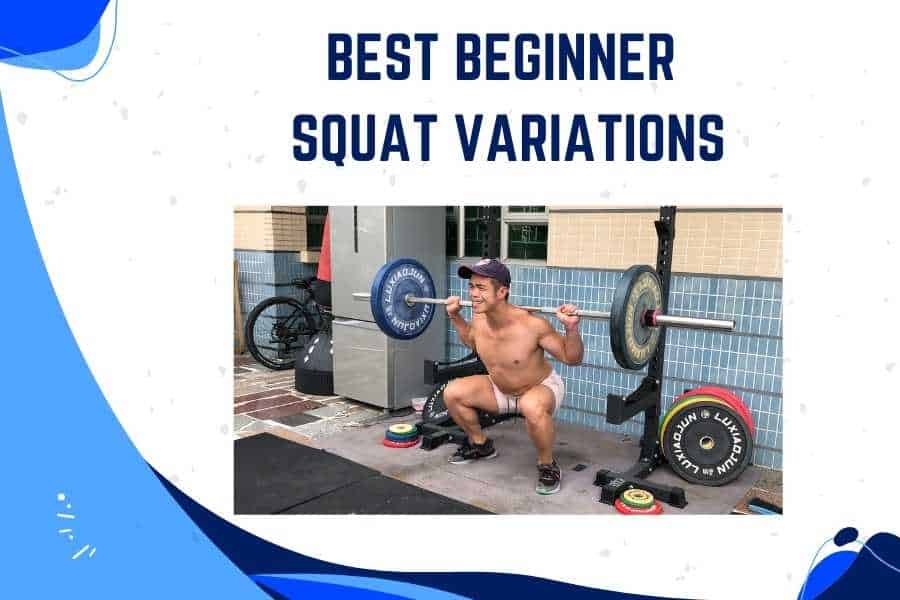Squats are a highly effective movement featured in most leg workouts. But with so many different types of squat variations, how do beginners know which ones to focus on? And which ones will help you to build bigger and stronger legs?
Bodyweight squats are generally best for beginners to start with. As the individual becomes stronger, they can then progress onto dumbbell goblet squats and finally barbell back squats. All variations are effective for people at different training levels.
Below, I explain the main types of squats, the differences between them, and the best ones to do if you’ve never trained legs before.
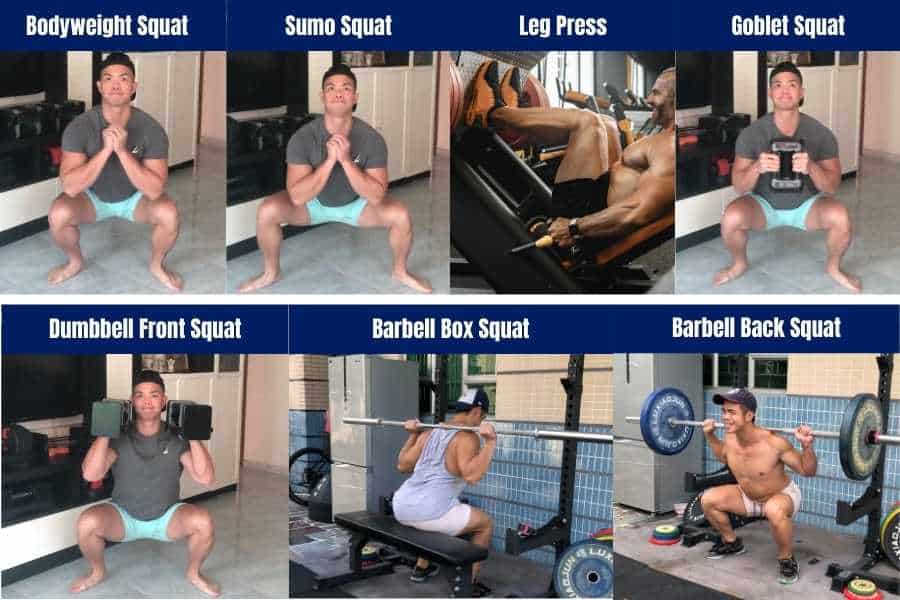
Types Of Squat Variations And Differences
Squat variations differ in the equipment used, weight-loading position, feet width, tempo, and range of motion. Many types of squatting variations exist. 5 of the most popular include the bodyweight, goblet, box, back, and front squat.
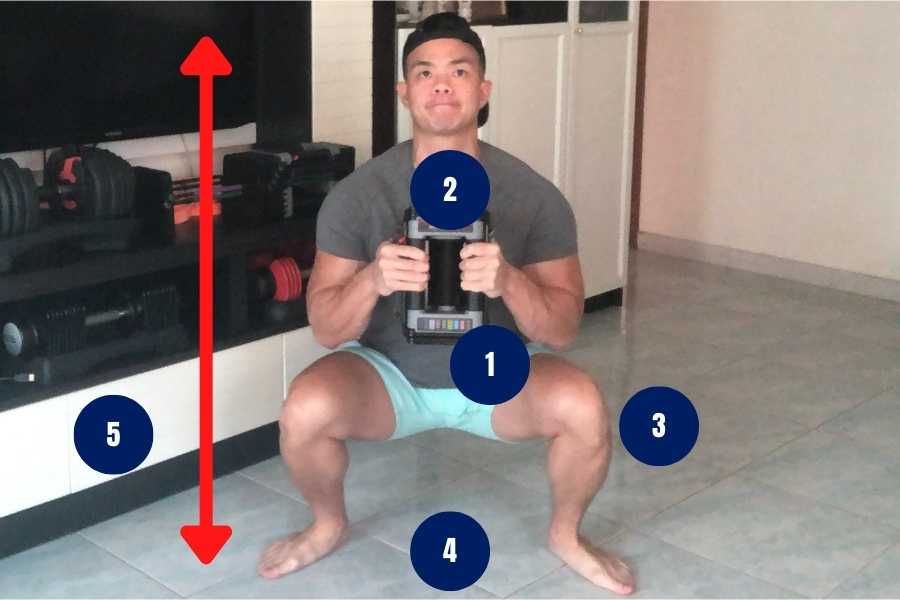
How different types of squat variations lead to different functional benefits:
- Equipment. Barbells offer the heaviest weights for building muscle. Dumbbells and kettlebells offer less weight but are easier for beginners to handle. Weight-free (i.e. body weight) is the most convenient and beginner-friendly. They can all be utilized to build leg muscle and tone.
- Weight-loading position. External weight can be loaded onto a squat in different types of positions; front or back. Front-loaded squats emphasize the anterior-chain muscles like the quadriceps. Back-loaded squats emphasize the posterior-chain muscles like the glutes, hamstrings, and lower back. Both types are effective for beginners.
- Range of motion (ROM). This describes your squat depth. In other words how close your buttocks reach the ground. Greater ROMs allow for more muscle activation but is generally harder to perform, especially for beginners with low ankle mobility. Lesser ROMs are usually easier for a beginner but also limit muscle activation.
- Feet width. The distance between your feet affects your squat ROM. Wider feet positions limit your squat depth. Narrower feet positions allow for greater depth. Beginners should start with a moderate shoulder-width neutral distance.
- Rep tempo. Squat repetitions (reps) can be performed at different speeds. Fast and explosive reps are great for increasing lower-body power. Slow or paused reps are ideal for building muscle and tone. Moderate rep tempos (2 seconds per rep) give beginners the best of both worlds.
What The Safest And Most Basic Squat Variation Looks Like
Using one’s own body weight is the most basic way to squat. It is also the safest squatting variation since there is no externally-loaded weight. Simply stand with the feet at a shoulder-width distance apart, keep the back straight, stick the chest out, and lower the buttocks towards the floor.
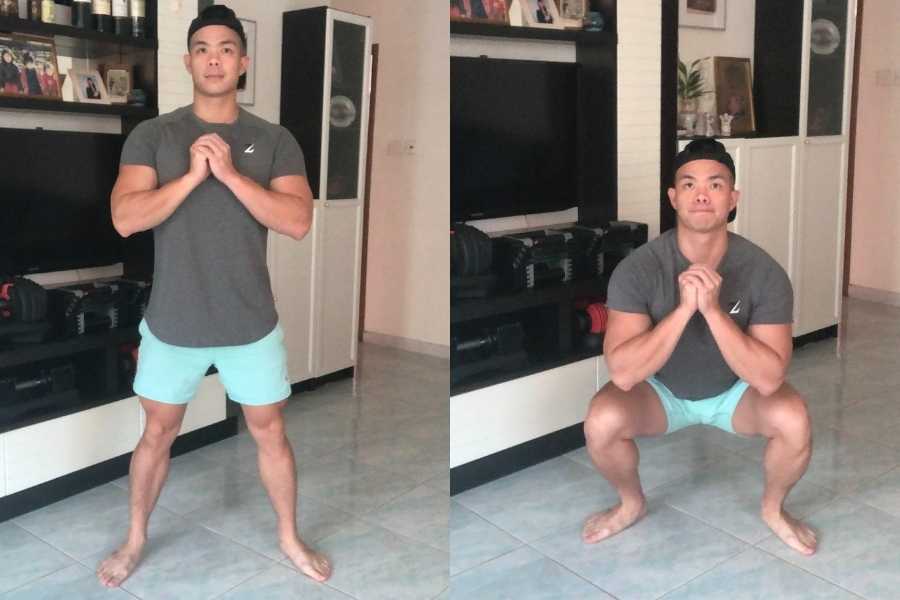
Squats are ideal for a skinny beginner to build a stronger lower body. And the bodyweight squat is a good place to start.
Technical cues to safely execute bodyweight squats with good form:
- Feet angle. Your feet should be a shoulder-width distance apart and angled slightly outwards in a natural position. Imagine drawing a line from your back to your navel. Aim to place your feet ~45° from this imaginary line. This is a neutral stance.
- Lower back. It’s important to keep your back straight and not let it round over (which can cause injuries). It helps to actively stick your chest out and keep your head up throughout the squat.
- Range of motion. Beginners should let their thighs reach parallel to the ground at the bottom of the squat before driving back up.
- Knee position. Keep them pointed outwards and avoid letting them cave in.
- Heel and ankle mobility. Press your toes and heels into the ground at all times. This keeps you stable and prevents balance issues.
These are general cues that should be applied to most (not all) squat variations.
6 Other Squat Variations For Beginners To Try
1) Sumo Squat
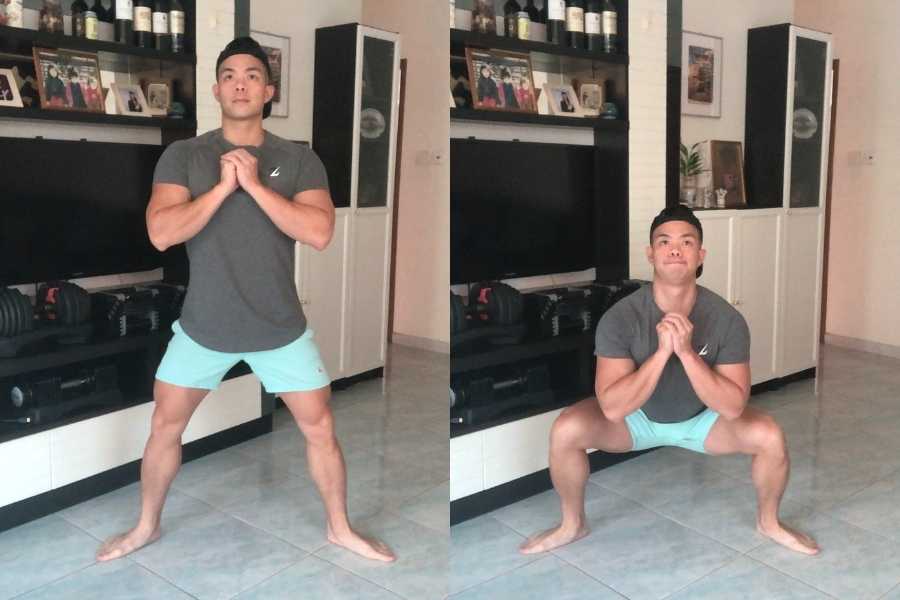
How to do it:
- Assume the standard bodyweight squat starting position.
- Take an extra step out on both feet to take on a wide stance.
- Angle the feet an extra 10° outwards.
- Lower the buttocks towards the ground while keeping a straight back.
- Stop when the thighs reach parallel to the ground before driving back up.
Why it’s effective:
Beginners can find it difficult to achieve a full ROM in the traditional bodyweight squat, mainly because it places a lot of tension on the quads (the smallest of the thigh muscles).
Achieving a full squatting ROM also requires a degree of knee strength that most beginners do not have.
The wide stance of the sumo squat shifts emphasis from the quads to the hamstrings, glutes, and inner thighs. This makes the exercise slightly easier.
Additionally, widening your stance reduces ROM and prevents your buttocks from dropping below the knees (which beginners often find uncomfortable and sometimes even painful).
Taken together, this makes the sumo squat one of the best variations for beginners to try alongside the traditional bodyweight variation.
It’s a great way for newbies to start building stronger legs and shaping their buttocks.
Recommended reps for beginners to start with:
4 sets of 10 reps.
2) Leg Press Machine
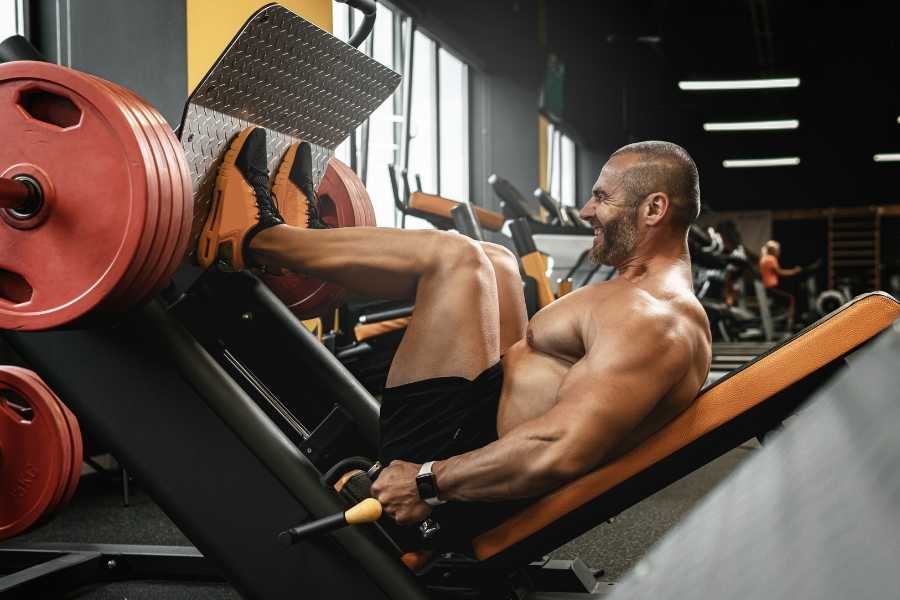
How to do it:
- Sit in the leg press machine with your back firmly pressed against the seat.
- Place your feet flat against the pushing plate at a shoulder-width distance.
- Have your feet facing toward the top of the pushing plate.
- Drive with your feet and stop just before your knees lock out.
Why it’s effective:
The leg press machine is technically not a squat.
However, I’ve decided to include it in the list because it’s a fantastic machine for replicating the squatting movement and activating a similar group of muscles (except for the core).
It’s also relatively safe because you don’t have to load any external weight on your back or front. The weight is instead supported by the machine.
Taken together, this makes the leg press a great exercise for beginners to start training the primary squat muscles without the risk that comes with using free weights.
You can position your feet higher on the plate to emphasize the hamstrings and glutes or lower on the plate for emphasizing the quads.
Recommended reps to start with:
4 sets of 12 reps.
3) Goblet Squat
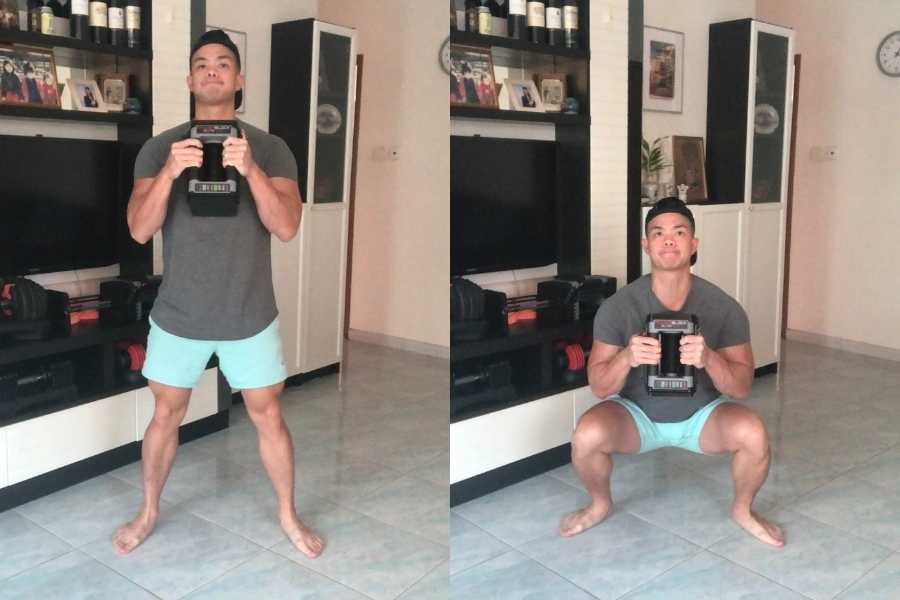
How to do it:
- Assume a shoulder-width neutral stance.
- Hold a dumbbell or kettlebell vertically and tight to your chest.
- Keep your head up, chest out, and elbows tucked into the ribcage.
- Lower the buttocks and stop as the thighs reach parallel to the ground.
- Drive back up.
Why it’s effective:
Bodyweight squats limit the weight you can lift and this means they can only get you so far in terms of building leg muscle and shaping the lower body.
Goblet squats are a suitable progression from the bodyweight squat since it utilizes an external weight. And adding weight to a bodyweight squat in this manner allows you to increase exercise intensity and promote muscle growth.
You can check out my other post for goblet squat weight recommendations.
The main benefit of a front-load is that the weight sits directly over the thighs. This shifts the emphasis away from the hamstrings and glutes to target the quads.
Additionally, front-loading squat variations are generally less intimidating and safer for beginners, compared to back-loaded squats.
That’s because holding the weight on your front feels more natural, and comfortable, and prevents your back from rounding over.
Overall- the goblet squat is both effective and convenient to perform, making it ideal for home muscle-building workouts.
Recommended reps to start with:
4 sets of 12 reps.
4) Dumbbell Front Squat
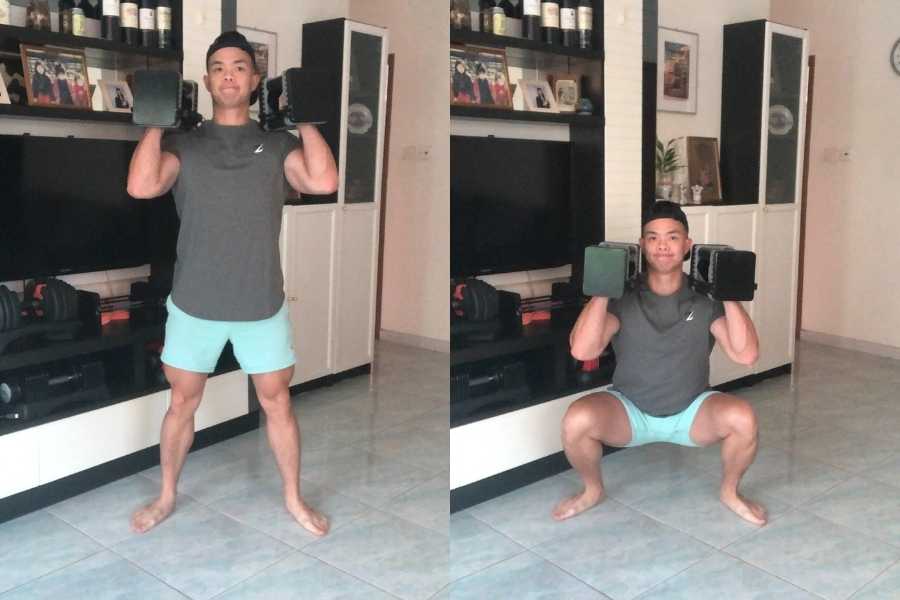
How to do it:
- Assume a shoulder-width neutral stance.
- Hold two dumbbells one in each hand and bring them up to the shoulders.
- Do not let the elbows flare out.
- Lower the buttocks and stop as the thighs reach parallel to the ground.
- Drive back up.
Why it’s effective:
This is another type of front-loading squat that can be performed with dumbbells. And just like with the goblet squat, the dumbbell front squat is great for emphasizing and strengthening weak quads.
It can be easy to outgrow the goblet squat, especially if you only have light dumbbells.
The main difference between the dumbbell front squat and the goblet variation is that you’re holding two dumbbells rather than one. And this allows you to load more weight and makes it a great progression from goblet squatting.
The weight also sits closer to your center of gravity in the dumbbell squat, and this can help beginners with poor mobility maintain balance during the movement.
Overall, this is another good squat variation for beginners to try at home if you have dumbbells.
You can check out my other post for dumbbell squat weight recommendations.
Recommended reps to start with:
4 sets of 8.
5) Barbell Box Squat
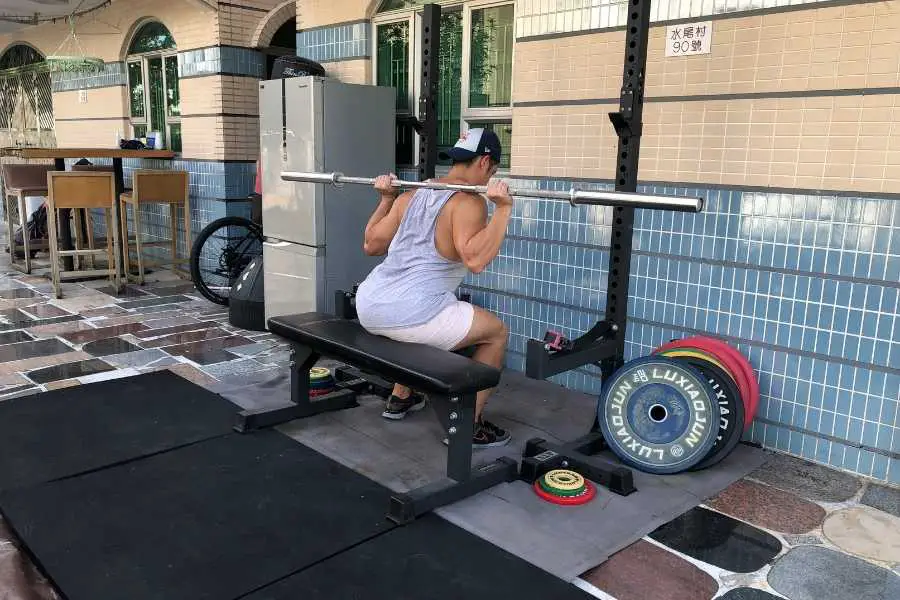
How to do it:
- Place a bench, box, or sturdy chair under a barbell rack (around 2 feet away from the barbell).
- Approach the barbell and rest it on your shoulders.
- Unload the barbell and take a few steps back.
- Lower your buttocks towards the bench/box/chair.
- Stop when your buttocks touch the bench/box/chair.
- Drive upwards.
Why it’s effective:
Barbell squats are a highly effective strength and muscle-building exercise because they allow for near-unlimited weight to be loaded. But they can also be intimidating and dangerous for beginners.
Having a box sat underneath your butt serves two purposes:
- Increases confidence. Knowing you have an object to support your weight at the end of the squat.
- Increases safety. A common fear with beginners and trained lifters alike is sinking too deep into the “hole” (a term used to describe the bottom of the squat) and not being able to drive back up. A box prevents you from over exceeding your natural ROM and sinking too deep.
Box squats can also be done with dumbbells, kettlebells, and even body weight.
I found them useful as a beginner to safely experience what it feels like to reach the maximum recommended ROM (i.e. thighs parallel to the ground).
Recommended reps to start with:
4 sets of 12.
6) Barbell Back Squat
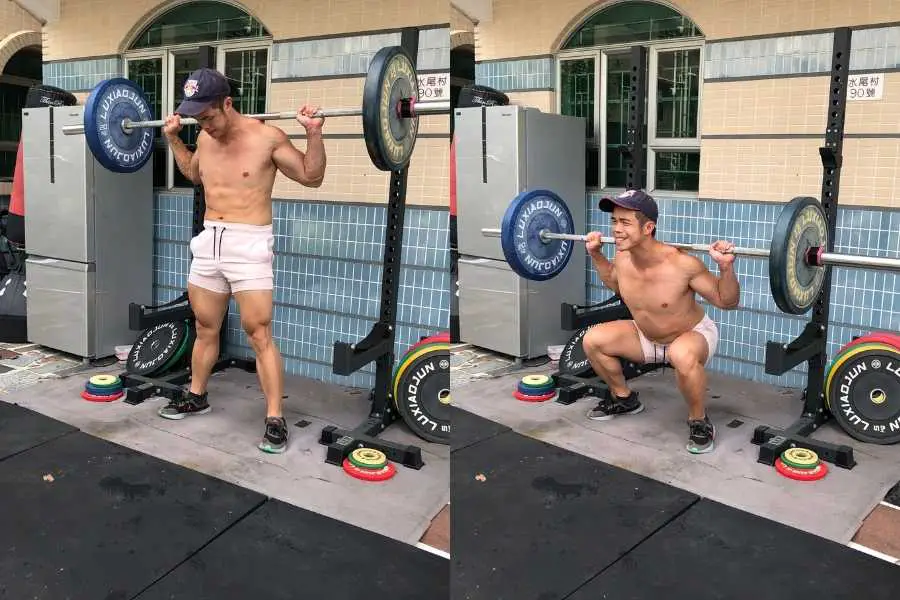
How to do it:
- Approach the racked barbell and support it just above your shoulder blades.
- Assume a neutral shoulder-width stance.
- Unrack the barbell and take a few steps backward/forward to clear the rack.
- Keep your back straight, chest out, and head up.
- Slowly lower the buttocks toward the ground.
- Stop when thighs reach parallel to the ground.
- Drive back up.
Why it’s effective:
Bodyweight and dumbbell squat variations are great for beginners because they’re relatively safe and convenient to perform. But they share a common problem; limited weight capacity.
If your goal is to maximize lower body muscle and strength, then you need to lift progressively heavier weights (you can check out beginner squat stats here if you like). And there’s only so much a dumbbell can be loaded with.
Barbells on the other hand can be loaded with near-limitless weight, making them the ideal progression for beginners who are ready to take their training to the next level.
This is a back-loading squat variation, meaning it emphasizes the posterior-chain muscles (hams and glutes). But it also hits your quads too.
The barbell back squat (both high- and low-bar variation) is a staple for anyone looking to build muscle, strength, and tone. It was a key exercise to help me go from skinny to muscular.
Recommended reps to start with:
4 sets of 6 reps.
Which Is The Best Squat Variation For Beginners?
There isn’t a single “best” squat variation. They’re all effective for different purposes and for people of different training levels.
Traditional and sumo bodyweight squats are great for general fitness and body toning. They’re also ideal for beginners to start working the legs and glutes. But they don’t provide a lot of weight.
Dumbbell/kettlebell goblet and front squats make a sensible next step for beginners who need to add more weight to keep their legs challenged and growing. However, you may eventually outgrow your dumbbells.
Barbell box and back squats are the best variation to build maximal muscle, strength, and tone due to the incomparable weights they offer. But it can be intimidating and unsafe for a beginner to start with barbell squats.
Here’s an 8-week squat progression plan for beginners to try:
| Week | Squat Variation | Recommended Sets And Reps | Recommended Weight |
|---|---|---|---|
| 1 | Sumo squats | 4 x 10 | Bodyweight |
| 2 | Bodyweight | 4 x 10 | Bodyweight |
| 3-4 | Goblet squats | 4 x 12 | 70% of 1-rep max |
| 5-6 | Dumbbell front squat | 4 x 8 | 80% of 1-rep max |
| 7 | Barbell box squat | 4 x 12 | 70% of 1-rep max |
| 8 | Barbell back squat | 4 x 6 | 85% of 1-rep max |
Aim for 2-3 workouts per week and avoid squatting every day. Remember, your legs need rest in order to recover and grow.
Conclusion
Many different types of squat variations exist and I’ve shared 7 of the best for beginners to try.
They’re all effective and you should include all of them in the scheme of an overall squatting progression plan.
This is the best way to build a bigger and stronger lower body.
You may also be interested in the downloadable Kalibre Blueprint PDF which details exactly how I gained 40lbs of lean muscle (it’s 100% free!). It details the exact exercises and nutrition (with printables) I used to go from skinny to ripped!

